Chemical programming for micro- and nanoarchitectonics of 3D/4D-printed thermoelectric materials
IF 13.2
1区 材料科学
Q1 CHEMISTRY, MULTIDISCIPLINARY
引用次数: 0
Abstract
Thermoelectric (TE) materials are important for TE devices that enable waste heat/cold harvesting, energy storage, and thermal sensing applications. Although significant development has been made in TE materials discovery, fabrication methods and designs for TE devices and modules remain a challenge. Recently, three-dimensional (3D) and four-dimensional (4D) printing of TE materials have become essential tools for creating efficient module designs with micro- to nano-scale structures while also minimizing waste generation. However, to achieve the desired print properties and TE material architecture from nano–micro to macro, chemical programming is necessary during feed/ink formulation for the printing procedure. In this review, we focused on TE materials and device fabrication progress in view of chemical programming for 3D/4D-printed TE materials. A brief introduction is provided of TE effects, TE materials, chemical programming approaches, and 3D/4D printing methods. We considered various classes of inorganic, carbon, and polymer-based TE materials to unveil the chemical programming approaches developed to print them. It was found that a significant gap exists in the transition from 3D to 4D printing of TE materials, which could be game-changing for smart applications of TE devices. Recent attempts of 4D printing suggest that chemically programmed smart material integration in TE devices could lead to success for finite applicable TE platforms. Finally, future perspectives and challenges are explored to identify limitations and possible ways forward. Overall, this review provides fresh insights on chemical programming approaches to implement 3D/4D printing of TE materials.
求助全文
约1分钟内获得全文
求助全文
来源期刊

Nano Today
工程技术-材料科学:综合
CiteScore
21.50
自引率
3.40%
发文量
305
审稿时长
40 days
期刊介绍:
Nano Today is a journal dedicated to publishing influential and innovative work in the field of nanoscience and technology. It covers a wide range of subject areas including biomaterials, materials chemistry, materials science, chemistry, bioengineering, biochemistry, genetics and molecular biology, engineering, and nanotechnology. The journal considers articles that inform readers about the latest research, breakthroughs, and topical issues in these fields. It provides comprehensive coverage through a mixture of peer-reviewed articles, research news, and information on key developments. Nano Today is abstracted and indexed in Science Citation Index, Ei Compendex, Embase, Scopus, and INSPEC.
 求助内容:
求助内容: 应助结果提醒方式:
应助结果提醒方式:


